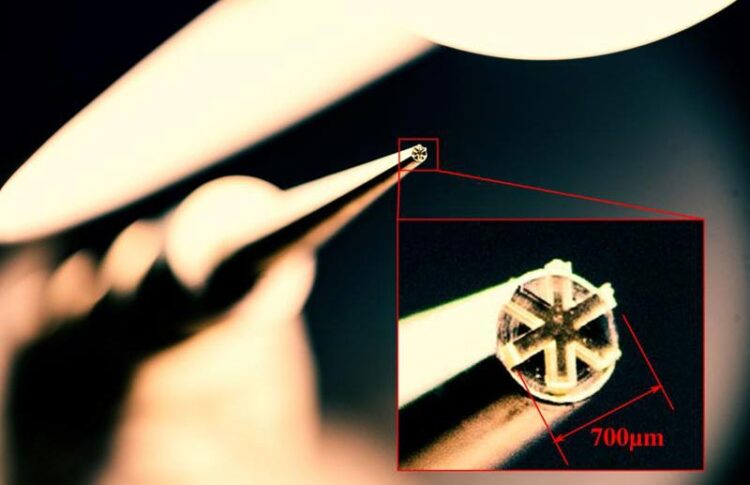Wobbling particles in the sky

A 700µm wide 3D printed particle resembling an ice crystal. It is placed on the tip of an injection needle before being dropped into the settling chamber.
© Johannes Seesing
Tiny particles such as ice crystals or ash particles tend to oscillate as they settle through the atmosphere. In their experiments, the scientists were able to track non-spherical particles of size smaller than 1 millimeter with unprecedented accuracy. Their observations gave rise to a model which can help to refine prediction on air pollutants or weather forecasts.
The atmosphere contains many tiny solid particles. Scientists from the Max Planck Institute for Dynamics and Self-Organization (MPI-DS) and the University of Göttingen in collaboration with the Centre national de la recherche scientifique (CNRS) in France and the university of Gothenburg, Sweden, now studied how such non-spherical particles settle in air. For this, they used a new precision apparatus equipped with high-speed cameras and a novel particle injection mechanism. Using a 3D-printer, they created particles of different shapes resembling discs of thickness as low as 50 micrometer and rods of length as high as 880 micrometers. Thanks to this setup, they could observe that particles tend to oscillate as they settle in quiescent air.
“So far, most studies on the behavior of such small particles were done with models in liquids since experiments in air are extremely challenging,” Mohsen Bagheri, group leader at MPI-DS, describes previous approaches. “However, the true settling dynamics could not be explored this way. They were now revealed in our experimental setting, directly measuring the motion of real-size particles, which are much heavier than the surrounding environment,” he continues.
The observed oscillation could impact the collision of individual particles, their travelling distance in the atmosphere and their interaction with the solar radiation.
Predicting the dynamics of particles
Typically, atmospheric particles are not perfectly spherical, but rather flattened or elongated structures. The scientists developed and tested a model to describe and predict the movement of such particles, which very accurately captures the experimental results. The new model can be used to study the dynamics and formation of particles clusters and the resulting effects in everyday life. “In particular, our results can help to better predict how long pollutants reside in the atmosphere or how precipitation is initiated in clouds,” summarizes Alain Pumir. The CNRS researcher developed the model together with his colleagues Bernhard Mehlig and Kristian Gustavsson.
In total, these new insights contribute to a more accurate understanding of atmospheric particles, and how they affect our environment and climate.
Wissenschaftliche Ansprechpartner:
Gholamhossein (Mohsen) Bagheri
Group leader, Scientist
+49 551 5176-391
gholamhossein.bagheri@ds.mpg.de
Originalpublikation:
https://journals.aps.org/prl/abstract/10.1103/PhysRevLett.132.034101
Weitere Informationen:
Media Contact
All latest news from the category: Earth Sciences
Earth Sciences (also referred to as Geosciences), which deals with basic issues surrounding our planet, plays a vital role in the area of energy and raw materials supply.
Earth Sciences comprises subjects such as geology, geography, geological informatics, paleontology, mineralogy, petrography, crystallography, geophysics, geodesy, glaciology, cartography, photogrammetry, meteorology and seismology, early-warning systems, earthquake research and polar research.
Newest articles

Sea slugs inspire highly stretchable biomedical sensor
USC Viterbi School of Engineering researcher Hangbo Zhao presents findings on highly stretchable and customizable microneedles for application in fields including neuroscience, tissue engineering, and wearable bioelectronics. The revolution in…

Twisting and binding matter waves with photons in a cavity
Precisely measuring the energy states of individual atoms has been a historical challenge for physicists due to atomic recoil. When an atom interacts with a photon, the atom “recoils” in…

Nanotubes, nanoparticles, and antibodies detect tiny amounts of fentanyl
New sensor is six orders of magnitude more sensitive than the next best thing. A research team at Pitt led by Alexander Star, a chemistry professor in the Kenneth P. Dietrich…





















